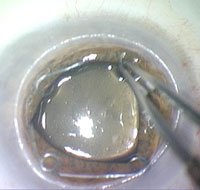New pupil expander easier to implant, gentle on the iris
The one-piece design with four loops provides balanced stretching and gentle holding of the iris, surgeon says.
Click Here to Manage Email Alerts
LISBON – A new pupil expander for bimanual phacoemulsification is easy to implant and gentle to use in complicated cataract eyes with small pupils, according to one surgeon.
“The device provides a stable mydriasis with no trauma to the iris tissue and no need for additional paracenteses,” said Boris Malyugin, MD, at the annual meeting of the European Society of Cataract and Refractive Surgeons.
The device has been designed and tested at the S.N. Fyodorov Eye Microsurgery Institute in Moscow and is currently used there as an alternative to other types of iris retractors.
“We have compared this new iris ring with other commercially available pupil expanders and found that it is easier to use and more gentle with the eye,” Dr. Malyugin said.
A study on cadaver eyes using scanning electronic microscopy after phaco showed that less damage to the iris tissue was caused by the new instrument than by conventional iris retractors, he said.
Easy insertion
Small pupils require different phaco techniques such as posterior synechiolysis, pupil stretching, iris retraction with iris hooks and iridoplasty.
“We created this new tool to obtain a safe, more stable and comfortable stretching of the pupil during bimanual MICS in complicated cases,” Dr. Malyugin said.
The device is a square, U-shaped, temporary implant with four circular loops that hold the iris at equidistant points. The result is a square, well- dilated pupil that allows safe and comfortable maneuvers.
The insertion is carried out through one paracentesis with the help of a Sinskey hook, Dr. Malyugin said. The pupil expander is positioned centrally and gently pushed at each angle to trap the iris in the four loops.
“We obtain a stable 5.5 mm to 6 mm pupil dilation, which is sufficient to perform safe bimanual phacoemulsification,” he said.
|
Images: Malyugin B |
Comparative study
A clinical study on 57 eyes of 56 patients with complicated cataracts was performed. The new iris ring was used in 25 eyes, and conventional iris hooks were used in 32 eyes. The two groups were comparable for patients’ age, sex and nucleus density.
“They were also comparable from the point of view of comorbidity, having more or less the same number of patients with uveitis, glaucoma, pseudoexfoliation syndrome or diabetes,” Dr. Malyugin said.
Intraoperative iris manipulation – either synechiolysis or iris stretching – was performed in about 30% of the patients in both groups.
Similar phaco parameters were used for all patients. Mean operating time was about 20 minutes, ultrasound time was 25 to 27 seconds, ultrasound power was 15% to 17%, and irrigating volume was about 100 mL. All procedures were performed with the Millennium Custom Control software (Bausch & Lomb).
A friendlier approach
Intraoperative complications such as iritis, transient IOP rise and microhyphema were comparable, Dr. Malyugin said.
“One or the other of these minor complications occurred in three patients with the new implant and in four patients with iris hooks,” he said.
Postoperative IOP level and endothelial cell loss were also comparable in the two groups.
Best corrected visual acuity (BCVA) was slightly better in the group implanted with the new device at 1 day and 1 week after surgery. At later follow-up dates, BCVA was similar to that of the conventional iris hooks group.
“Our device proved as safe and effective as other long-in-use iris retractors. However, compared to them, it has the advantage of being friendlier with the eye, due to the well-distributed stretching and gentle holding of the delicate iris tissue, and to the easier and less traumatic implantation. While other types of iris hooks need additional corneal paracenteses, this instrument only needs one, and it has no sharp or pointed endings that can damage the eye,” Dr. Malyugin said.
The device is not yet commercially available. It is currently undergoing clinical trials in Russia, he said.
For Your Information:
- Boris Malyugin, MD, can be reached at the S.N. Fyodorov Eye Microsurgery State Institution, 59a Beskudnikovsky Blvd., 127486 Moscow, Russia; +7-095-488-8511; fax: +7-095-906-1775; e-mail: malyugin@online.ru. Dr. Malyugin has no financial interest in the pupil expander. He has a patent on the product.
- Michela Cimberle is an OSN Correspondent based in Treviso, Italy.


